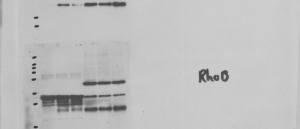Western blotting: a summary
What is western blotting?
Western blotting (or immunoblotting) is a well-established biochemical technique that detects specific proteins in complex samples and has applications from basic research to the diagnosis of infectious diseases. Western blotting can be used to determine quantity, molecular weight and post-translational modifications of proteins and can therefore be a powerful tool to monitor changes in proteins, including expression and modifications.
How does western blotting work?
Essentially, western blotting has three main elements: separate proteins in the sample by size, transfer to a solid support and visualize the target protein using primary and secondary antibodies.
The first stage in western blotting is to separate the proteins in the sample, which is done by gel electrophoresis. The proteins can be separated by a variety of factors, including isoelectric point, molecular weight or electric charge, and this is dictated by the treatment of the sample and the nature of the gel. The most common type – termed SDS-PAGE – utilizes polyacrylamide gels and buffers loaded with sodium dodecyl sulfate, which results in denatured proteins that are separated according to molecular mass.
The separated proteins have to be made accessible to antibody detection, and this is done by transfer from the gel onto a membrane. The proteins are most commonly transferred in a process called electroblotting, which uses an electric current to pull the proteins from the gel onto the membrane, maintaining the organization they had in the gel.
The membrane is ‘blocked’ to prevent non-specific antibody binding, and then stained with primary antibodies specific to the target protein. Finally, a tagged secondary antibody is added that binds to the primary antibody, and the tagged antibodies can then be visualized by a variety of methods, such as immunofluorescence, enabling indirect detection of the target protein.
The history of western blotting
Invented in 1979, 2019 saw western blotting’s 40th birthday, a milestone that was celebrated by many across the world, including BioTechniques. The name western blot is a play on the Southern blot, a technique used for the detection of DNA.
Featured
Western blotting forms the bedrock of many protein studies, with the technique cited in 9% of all protein related papers. The technique had its 40th birthday in 2019, an event that was widely celebrated in the life sciences.
With the well-known technique reaching a big birthday milestone, is the western blot still going strong, or has it reached a midlife crisis?
Western blotting has, despite the initial unclear potential and its limitations, matured into an essential biochemical technique.
South, north, east and west-ern: the story of how the western blot came into being
The western blot may appear to be just another staple lab technique. However, there are some stories surrounding its invention that are definitely worth knowing.
 In Focus: Western blotting
In Focus: Western blotting Western blotting: 40 years on
Western blotting: 40 years on
